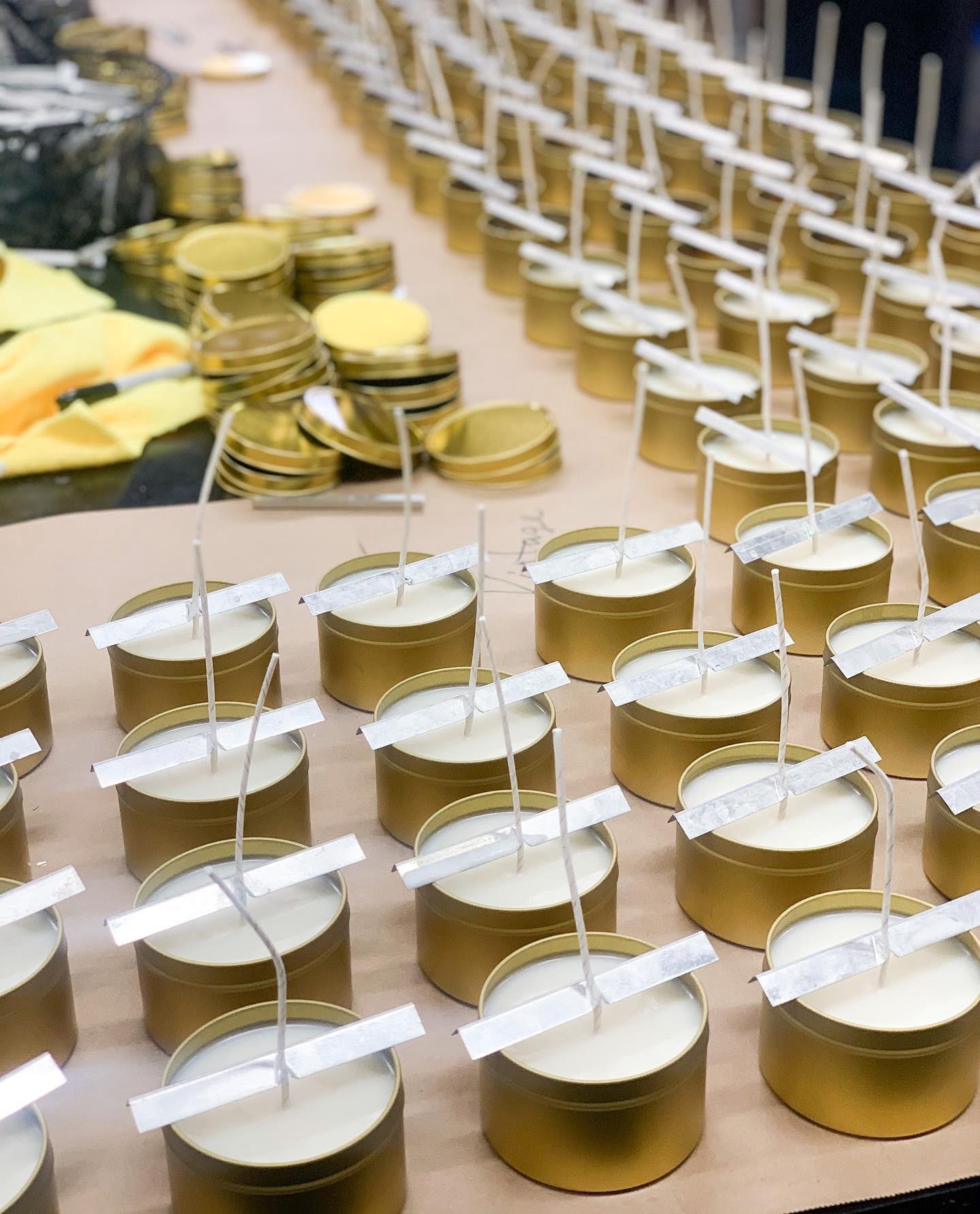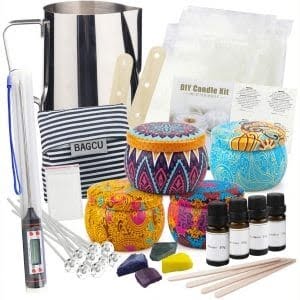When it comes to making candles, one of the most crucial steps is properly securing the wick. Without a securely anchored wick, your candle may burn unevenly, flicker excessively, or even become dangerous. In this article, we will explore the importance of securing the wick in candle making and provide you with detailed instructions on how to ensure that your wick stays in place throughout the burning process.
Securing the wick in candle making is essential for several reasons. Firstly, it helps to create an even burn by keeping the flame centered and stable. This not only improves the aesthetics of your candle but also ensures that it burns efficiently and effectively. Additionally, a properly secured wick lowers the risk of fires and accidents by preventing the flame from tipping over or coming into contact with unburned wax.
To achieve optimal results, it is important to understand the different types of wicks available and their various characteristics. From cotton core wicks to braided wicks, each type has its own unique properties that can influence burning behavior and performance. By understanding these differences, you can select the right type and size of wick for your specific candle-making project.
In this article, we will guide you through everything you need to know about securing the wick when making candles. We will discuss different types of wicks, provide tips on selecting the appropriate size based on your candle’s diameter and wax type, explain how to prepare the wick for optimal burning and stability, and explore various techniques for anchoring and embedding the wick in different types of candles.
By following our step-by-step instructions and troubleshooting common issues along the way, you will be able to master this crucial aspect of candle making for successful and safe results.
Understanding the Various Types of Wick
When it comes to securing the wick in candle making, understanding the various types of wicks available is essential. Different types of wicks have varying characteristics that can affect the way a candle burns and how well it stays secure during the burning process.
One type of wick commonly used in candle making is the cotton wick. Cotton wicks are known for their reliability and ability to burn cleanly. They are versatile and can be used with a wide range of wax types, including soy wax, paraffin wax, and beeswax.
Cotton wicks come in different thicknesses or “ply,” which refers to the number of strands braided together to form the wick. Thicker ply wicks tend to produce a larger flame, while thinner ply wicks create a smaller flame.
Another type of wick commonly used is the hemp or hemp core wick. Hemp wicks are made from natural fibers and are known for their slow, even burn. They are often used with beeswax candles because they provide a stable flame and help minimize soot buildup. Hemp core wicks have a thin, cotton outer layer wrapped around a hemp core to enhance performance.
Wooden wicks have gained popularity in recent years due to their unique crackling sound reminiscent of a burning fireplace. These wicks are made from sustainably sourced wood and offer an aesthetic appeal to candles. Wooden wicks typically require wider container openings or pillar candle molds due to their larger size and need for proper air circulation.
| Wick Type | Characteristics |
|---|---|
| Cotton Wick | Reliable, clean burning; available in different ply thicknesses |
| Hemp Wick | Slow, even burn; often used with beeswax candles; hemp core wicks have a thin cotton layer wrapped around a hemp core |
| Wooden Wick | Offers crackling sound; made from sustainably sourced wood; requires wider container openings or pillar candle molds |
When selecting a wick for your candle, consider factors such as the type of wax you are using, the diameter of your candle, and the desired burn characteristics. Testing different wicks with small sample candles can help determine which type and size will work best for your specific candle making project. Each type of wick has its own unique burning properties and it is important to choose the one that suits your needs and preferences.
Selecting the Right Wick Size
When it comes to candle making, selecting the right wick size is crucial for ensuring a successful burn and optimal performance of the candle. The size of the wick determines how much fuel is being drawn up from the wax, which directly impacts the flame’s size, brightness, and how evenly the candle melts. Here are some tips on choosing the appropriate wick size based on the candle’s diameter and wax type:
- Consider the diameter of your candle: The first step in selecting the right wick size is considering the diameter of your candle. Typically, you’ll find that wick manufacturers provide recommendations for which wick size to use based on various diameter ranges. These recommendations ensure that your candle has enough fuel to burn properly without excessive smoking or tunneling.
- Take into account your wax type: Different wax types have different characteristics that can affect how well a particular wick burns. For example, soy wax tends to have a lower melting point than other types of wax, so you may need a smaller size wick to prevent excessive smoking or mushrooming. Be sure to check with your specific wax manufacturer for any recommendations they may have regarding wick sizing.
- Experiment and test: Although guidelines and recommendations can be helpful when starting out, it’s important to remember that each batch of candles can behave differently due to variations in ingredients and environmental factors. As such, it is highly recommended to experiment and conduct burn tests with different wicks to determine which one works best for your specific candles.
To make this process easier, many suppliers offer sample packs of various wick sizes for you to test before committing to a larger quantity purchase. By using these samples and conducting burn tests, you can observe how each size performs in terms of flame height, melt pool diameter, and overall burn quality.
By taking into consideration the diameter of your candles and their specific wax type while using experimentation and testing as part of your process, you can confidently select the right wick size for each unique candle you create. This ensures that your candles burn cleanly, evenly, and enjoy an extended burn time.
Preparing the Wick
When it comes to candle making, priming the wick is a crucial step that ensures optimal burning and stability. Priming the wick involves treating it with a flame-resistant coating, which not only helps promote even burning but also strengthens the wick to prevent it from unraveling or breaking during use. This section will provide a step-by-step guide on how to properly prime the wick for optimal performance.
Step 1: Cut the Wick
Start by cutting the wick according to the desired length for your candle. It’s important to consider the size of your container or pillar when determining the length of the wick. A general rule of thumb is to leave about 1/2 inch (1.3 cm) above the top surface of the candle for trimming later. If you’re unsure about the length, you can always cut it longer and trim it later.
Step 2: Dip in Wax
Next, prepare a small container with melted wax at around 180-190 degrees Fahrenheit (82-88 degrees Celsius). Hold one end of the wick with tweezers or chopsticks and carefully dip it into the melted wax. Make sure to fully submerge and saturate the entire length of the wick in wax. This process not only adds strength to the wick but also makes it easier to light when burning your candle.
Step 3: Remove Excess Wax
After dipping, carefully lift out the wick and allow any excess wax to drip off back into your main container of melted wax. You can gently shake or tap off any excess while ensuring that most of the wax remains on the wick. It’s essential not to remove all excess wax, as this coating is what enhances flame retardancy and burn stability.
Step 4: Hang and Dry
To let the primed wick dry and harden, you can suspend it by tying the loose end to a pencil or dowel rod and then hanging it somewhere where it won’t touch any surfaces. This will prevent the wax from sticking to anything while it dries. It’s best to leave the wick to dry for at least 24 hours before using it in your candles.
By carefully following these steps to prime your wick, you’ll have a stronger, more stable wick that will burn evenly and safely throughout the life of your candle. Properly primed wicks also help reduce common issues such as tunnelling or excessive smoking. Taking the time to properly prepare your wicks will contribute to the overall quality of your handmade candles.
Anchoring the Wick in Container Candles
When making container candles, it is crucial to securely anchor the wick to the container. This ensures that the wick stays in place during the burning process and prevents potential safety hazards. There are several techniques and tools that can be used to achieve a secure attachment between the wick and the container.
One common method is to use a wick sticker or adhesive tab. These stickers are typically made of double-sided tape or a heat-resistant adhesive. To use this technique, simply peel off one side of the sticker and press it firmly onto the base of the wick tab. Then, peel off the other side of the sticker and carefully attach it to the bottom center of your container. Make sure to press down firmly to ensure a strong bond.
Another option for anchoring the wick in container candles is through the use of a wick sustainer or wick clip. These small metal devices are attached to the end of the wick and then placed at the bottom center of the container. Wick sustainers come in various sizes to accommodate different candle sizes and can be easily secured using hot glue or wax adhesive.
It’s important to note that when using either method, it’s essential to center the wick in your container before securing it. This will help ensure an even burn throughout your candle’s lifespan. Additionally, avoid pulling or tugging on the wick after it has been anchored, as this can weaken its bond with the container.
By properly anchoring your wick in container candles, you can have peace of mind knowing that it will stay securely in place during burning. Experimenting with different techniques is encouraged, as each candle maker may find their preferred method based on personal preference and specific candle designs.
Embedding the Wick in Pillar Candles
Pillar candles are a popular choice among candle enthusiasts due to their elegant and decorative appeal. However, ensuring that the wick remains in place while the candle burns can be challenging. Embedding the wick securely in pillar candles is crucial to prevent it from shifting or leaning as the wax melts away. Follow these step-by-step instructions for a successful embedding process.
First, measure and cut the wick according to the desired height of your pillar candle. It is recommended to leave a few inches of excess wick for easier handling during the embedding process. Next, dip one end of the cut wick into melted wax and quickly press it onto the bottom center of the container mold. Hold it firmly for a few seconds until the wax sets and secures the wick in place.
Once the initial anchor is set, you can start pouring melted wax into the mold. As you pour, continuously monitor and adjust the position of the wick to ensure it stays centered and straight within the candle. To help with this, some crafters use tools like wooden skewers or chopsticks to gently guide and position the wick as needed during pouring.
As you pour more wax into your mold, make sure that it does not cover or submerge any part of your embedded wick. Leave some space at the top of your mold to allow for any potential expansion when cooling. Once you have poured all of your desired wax into your mold, allow sufficient time for it to cool completely before attempting to remove your finished pillar candle.
By following these detailed instructions when embedding a wick in pillar candles, you can confidently create beautiful candles that remain stationary while burning evenly throughout their lifespan. Remember to practice caution when working with hot wax and always prioritize safety during your candle-making process.
Tips for Securing the Wick in Floating Candles
Floating candles add a beautiful and serene ambiance to any space, but keeping the wick securely in place can be a challenge. The unique nature of floating candles requires special techniques to ensure that the wick does not move or extinguish while in use. In this section, we will explore creative methods to help you secure the wick in floating candles effectively.
Using Metal Clips
One popular method for securing the wick in floating candles is by using metal clips. These clips are designed specifically for floating candles and are easily available at craft stores or online.
To use them, simply attach the clip to the base of the wick and position it snugly against the candle’s surface, making sure it doesn’t touch the sides of the container. The metal clip will anchor the wick securely in place while providing enough flexibility for vertical movement as the candle burns.
Creating a Wick Trap
Another effective technique for securing wicks in floating candles is to create a “wick trap.” To make a wick trap, take a small piece of craft wire or paperclip and bend it into a loop shape. Place this loop around the base of the wick, just above where it enters the wax pool.
Gently press down on the loop so that it touches both sides of the container, effectively trapping the wick and preventing it from drifting away. This method ensures that your wick stays centered while allowing it to move freely within its designated area.
Using Double-Sided Tape
If you prefer a more discreet approach, using double-sided tape can be an effective way to secure your wicks in floating candles. Cut small pieces of double-sided tape and stick them to both ends of a craft stick or toothpick. Carefully press one end of each piece of tape onto either side of the base of your wick, ensuring they adhere tightly.
Then gently press the tape-covered stick or toothpick onto the bottom of the container, with the wick suspended in the wax above. The double-sided tape will act as an anchor, keeping the wick in place without being visible once the candle is lit.
Remember that regardless of the method you choose, it’s essential to conduct a test burn before using your floating candles. This allows you to ensure that the wick remains secure and centered throughout its burn time and prevents any safety issues. With these creative methods, you can enjoy the beauty of floating candles while ensuring that their wicks stay securely in place.
Troubleshooting Common Wick Security Issues
When it comes to candle making, ensuring the secure placement of the wick is essential for a successful and safe burning experience. However, sometimes issues can arise where the wick may drift, sink, or simply not stay centered. In this section, we will address these common wick security issues and provide some helpful solutions.
- Wick Drifting: One common issue faced by candle makers is the drifting of the wick towards one side of the container as it burns. This can result in uneven burning and a shortened burn time. To combat this problem, try using a wick centering device.
These devices are often made of metal and can be placed on top of the container while the wax is still liquid. They will keep the wick centered as it burns, ensuring an even distribution of heat and prolonging the candle’s lifespan. - Wick Sinking: Another problem that may occur is when the wick sinks into the melted wax pool instead of staying at its original position. This can cause a weak flame and inefficient burning. To prevent this issue, ensure that you have chosen the appropriate wick size for your candle diameter and wax type (as discussed in Section 3).
If you’ve selected a wick that’s too small, it may not have enough strength to stay upright in the hot wax. Consider testing different wick sizes until you find one that remains stable throughout your candle’s burn time. - Wick Not Staying Centered: It can be frustrating when your carefully crafted candle has a wandering wick that refuses to stay centered during burning. In this case, there are a few tricks you can try. First, make sure your dyes or fragrances are not causing excessive heat around the wick, which could make it lean to one side.
Additionally, consider using a small amount of melted wax around the base of the container to create stability for the wick before pouring in the rest of the wax. Alternatively, you can try using wick stickers or adhesive tabs to anchor the wick in place.
By troubleshooting these common wick security issues, you can ensure a smooth and enjoyable candle burning experience. Remember that trial and error may be necessary to find the perfect solution for your specific candle-making process, so don’t be afraid to experiment with different techniques until you achieve the desired results.
Additional Wick Security Measures
When it comes to securing the wick in candle making, there are some additional measures you can take to ensure that it stays in place, especially when working with unique candle designs. While the previous sections have provided tips and techniques for anchoring the wick in container candles, embedding it in pillar candles, and making floating candles, this section will focus on optional techniques using wick stickers or glue guns.
One option is to use wick stickers, which are small adhesive tabs specifically designed for candle making. These stickers can be adhered to the bottom of the wick tab and then pressed onto the bottom of the container or mold. Wick stickers are particularly useful when working with containers that have uneven surfaces or if you want a quick and easy way to secure the wick without using hot glue or other adhesives.
Another option is to use a glue gun to secure the wick. This method requires caution and precision because hot glue can be messy and potentially cause burns if not handled properly. To use a glue gun, simply apply a small amount of hot glue to the base of the wick tab and press it firmly onto the bottom of the container or mold.
Be sure to work quickly as hot glue dries fast. Additionally, avoid using too much glue as it may interfere with proper burning.
Both wick stickers and glue guns provide additional stability for your candle’s wick, giving you peace of mind that it will stay in place during burning. Remember to always follow safety guidelines when working with hot glue guns and handle them carefully to prevent accidents or injuries.
By utilizing these optional techniques, you can further enhance the security of your candle’s wick in unique designs. Whether you choose to use wick stickers or a glue gun, always prioritize safety and take necessary precautions while handling these tools. With these additional measures in place, you can confidently create beautiful and stable candles that burn evenly and safely from start to finish.
Conclusion
In conclusion, it is essential to properly secure the wick when making candles to ensure both successful and safe candle making. Throughout this article, we have explored the various types of wicks available, discussed how to select the right size for different candles, and provided step-by-step instructions for preparing and anchoring the wick in different types of candles.
By following these guidelines and implementing the techniques outlined in this article, you can prevent common wick security issues such as drifting, sinking, or not staying centered. Troubleshooting suggestions have also been provided in case you encounter any problems along the way.
Remember that additional measures can be taken to further stabilize the wick in unique candle designs. Optional techniques like using wick stickers or glue guns can provide extra support and peace of mind.
Overall, securing the wick is crucial not only for the aesthetic appeal of your candles but also for their safe burning. Taking the time to properly anchor and embed the wick will ensure that your candles burn consistently and evenly, providing a beautiful and enjoyable experience for yourself or those you gift them to. So remember, always prioritize securing the wick when making candles for successful and safe results.
Frequently Asked Questions
How do I secure the wick in candle?
Securing the wick in a candle involves carefully anchoring it to the bottom of the container or mold. The first step is to measure and cut the wick to the desired length, making sure it is long enough to extend a few inches above the top of the container. Once you have your pre-cut wick, you can use various methods to secure it in place.
One commonly used technique is to attach a small metal disc, known as a wick tab or sustainer, to the end of the wick using hot glue or adhesive. The metal disc provides weight and stability when placed at the bottom of the candle container or mold, preventing the wick from moving around during pouring and setting.
How do you anchor a wick?
Anchoring a wick involves securely attaching it to a suitable anchor point that will hold it in place throughout the candle-making process. Depending on your preferences and available materials, there are several ways you can anchor a wick. One option is to tie a small metal washer or nut onto one end of the wick; this heavy object will serve as an anchor when placed at the bottom of your container or mold.
Alternatively, you can affix a clip or clothespin onto one end of the wick using heat-resistant glue, allowing you to easily secure it to the side of your container. Whichever method you choose, remember to ensure that your chosen anchor point is stable and capable of withstanding any heat or pressure generated during candle-making.
How do you keep a candle wick from falling over?
To prevent a candle wick from falling over during burning, it’s important to take some precautions while setting up and pouring your candles. Firstly, make sure that your chosen vessel or mold for making candles has sufficient width and stability for holding the wick upright during use. If necessary, consider using molds specifically designed for candles which have built-in structures such as holes or grooves where you can insert and secure your wicks firmly.
Additionally, you can use a wick holder or centering device to keep the wick in place while pouring the melted wax. These devices typically consist of a metal rod with clips or clamps that hold the wick taut and centered within the container. By adequately preparing your candle-making setup and utilizing such tools, you can minimize the risk of your candle wick falling over as it burns.

Welcome to my candle making blog! In this blog, I will be sharing my tips and tricks for making candles. I will also be sharing some of my favorite recipes.





